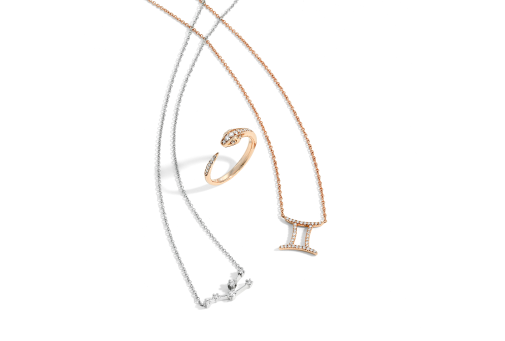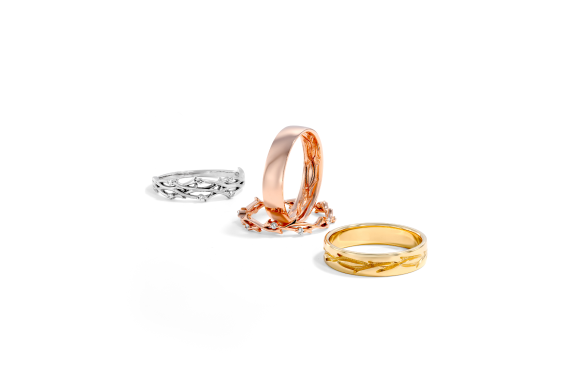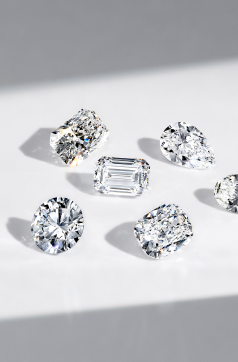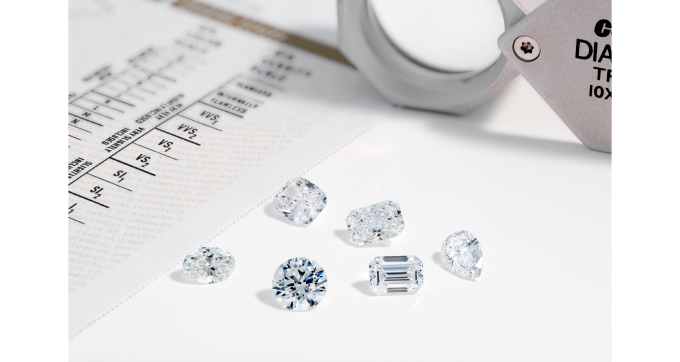Diamond Types - Natural Diamond
Education Center
Education CenterEverything You Need to Know About Natural Diamonds
Natural diamonds are a thing of beauty. But what are they - and how'd we start using them? Well, diamonds were first traded as early as 4th Century BCE in present-day India. By the 1400s, they became a fashion statement used by Europe's elite. Diamonds remain highly valuable to this day - though you no longer have to be an aristocrat to buy them.
As for what they are… That's a harder question to answer. This article will cover how natural diamonds occur, whether they’re rare (or not), and their impact on the environment. We'll also touch on the difference between natural and lab-grown diamonds.
What is a Natural Diamond
Diamonds are a crowd-pleaser, to be sure, but what the heck are they? (Other than an incredibly beautiful, incredibly shiny rock).
A diamond is not only the hardest naturally occurring substance on earth. It's also older than life itself. Each gem is as unique as a snowflake. Who knew some mineral composed of crushed carbon atoms would become the symbol of undying love?
A Diamond in the Rough
Diamonds have a hot and heavy history. Literally. Billions of years ago, carbon atoms were crushed together by extreme heat and pressure beneath the earth's crust. These atoms formed the shiny crystalline structure we know and love today. Diamonds were initially formed around 80-100 miles below the surface. They remained there until hundreds of millions of years ago, when they were pushed to the surface by ancient volcanic eruptions.
Are Diamonds Rare?
Since the diamonds we mine today were formed so many billions of years ago, so deep underground, we are limited to those diamonds which have been pushed close enough to the surface to be discovered.
There has not been a substantial diamond deposit found in over 30 years, and the number of diamonds found per year peaked in 2005, but does that mean they're rare? The truth is that there are more than enough diamonds to go around. Large diamond retailers have stores of diamonds stashed away for rainy days, making them appear more rare and thus more valuable.
So don't worry. We're not running out of diamonds anytime soon.
Keeping Sustainability in "Mined"
Although diamond mining doesn't have the kindest history, its future looks bright. Today 99.8% of diamonds mined are supervised by the Kimberly Process. This initiative was designed to improve the diamond industry's transparency and eliminate the trade of conflict diamonds.
Many larger diamond companies are making the safety of miners and their communities a priority. At Keyzar, we follow the strictest practices to ensure our diamonds are conflict-free. In India, many jobs, along with funding for schools and hospitals, are created by the mining industry. Additionally, 1.5 million small-scale miners and families in Africa and South America are supported and supply around 15% of the world's diamonds.
Earth Conscious
There is inherently a lot of damage that comes along with the mining industry, but many mining companies are working towards becoming carbon neutral, following strict ecological protection rules. 85% of diamonds are mined by large companies that have pledged to protect the environment and work with local communities and governments to do so:
- The government monitors mines to ensure they follow environmental regulations
- Modern mining uses 37% less energy than before
- Some Canadian mines use wind energy to power their mining sites
- 83% of the water used in diamond mining is recycled
Natural Diamonds Vs. Lab-Grown
Today, there are two choices when it comes to diamond buying: natural earth-mined diamonds and lab-grown diamonds. These two diamonds are identical down to the atomical structure, so what sets them apart?
Let's Talk Price
Due to artificially inflated prices, mined diamonds cost significantly more than lab-grown. We often see prices anywhere from 30%-60% higher.
Larger diamonds of both types can be hard to find and therefore have a higher price tag, but you'll save more overall on a lab-grown diamond of the same cut and quality. If you're budget-conscious, consider checking out a lab-grown alternative.
Super Sustainable
Lab-grown diamonds are entirely renewable. This keeps the average cost down and the sustainability up. There is also no question of ethicality, and since no holes are being dug, they're much more environmentally conscious.
Conclusion
What's that on your finger? Just a couple of billion years mixed with a little carbon.
It goes without saying that diamonds are beautiful, but their history & tradition makes them a truly unique symbol of everlasting romance. Their value has shined through as a sign of wealth, beauty, and strength throughout history.



